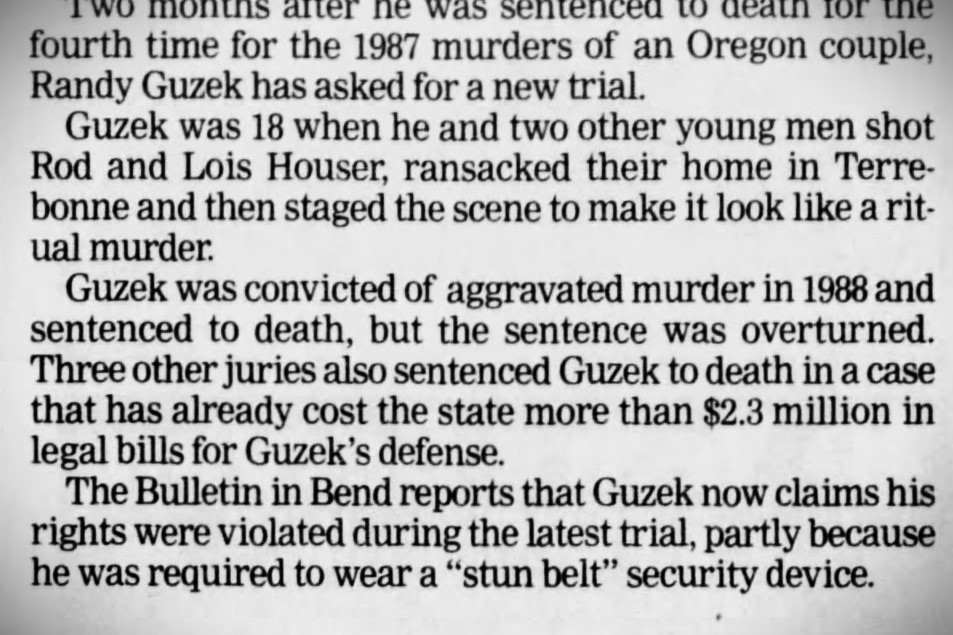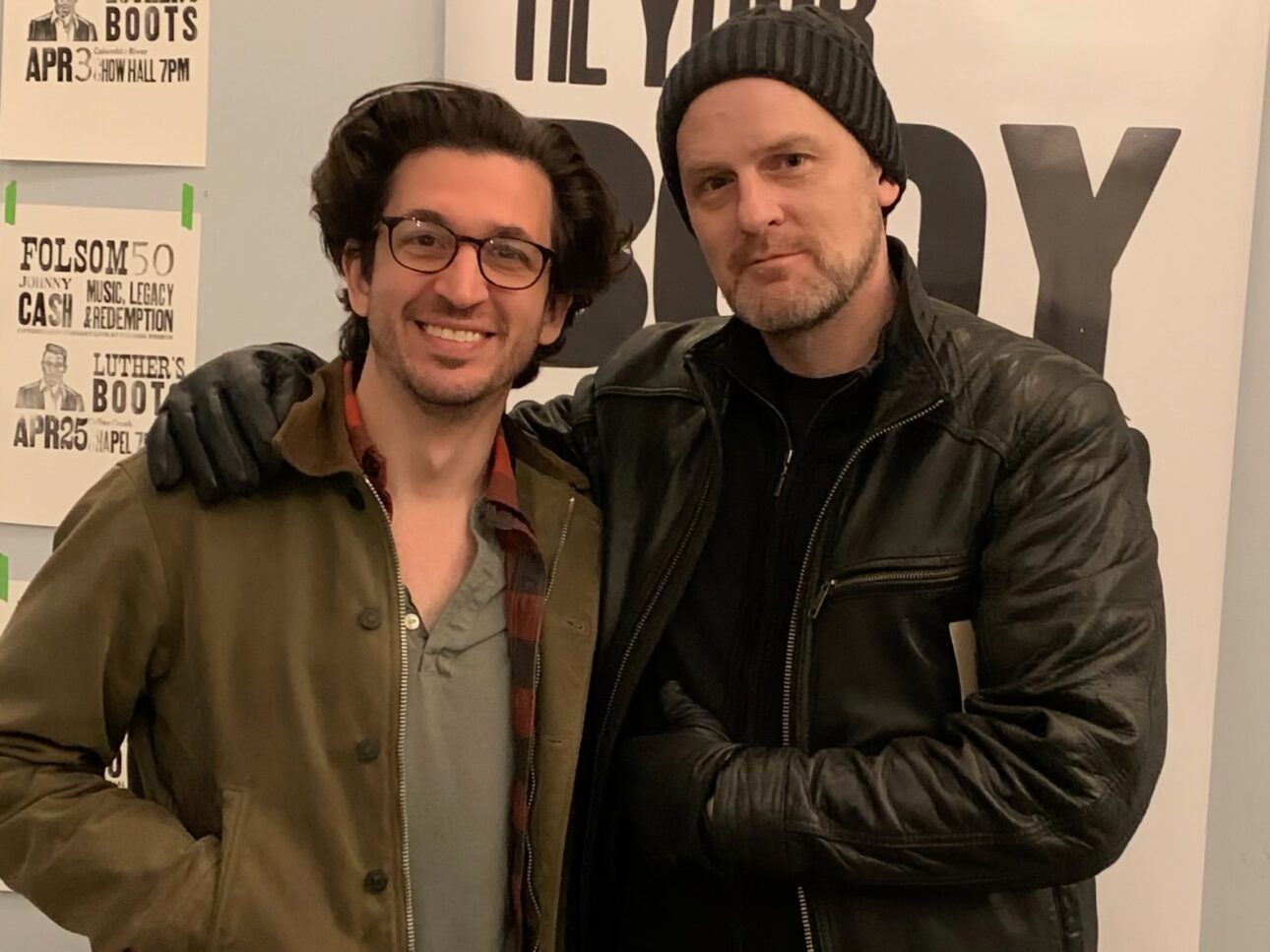True goodness
is like water.
Water’s good for everything.
It doesn’t compete.
It goes right
To the low loathsome places,
and so finds the way.
From the Tao Te Ching, translated by the late Ursula K. Le Guin of Portland, Oregon
“This majestic waterfall is a confrontation between stream and rock,” says Randy Lee Guzek in his high-pitched, song-song voice. On a crisp Salem morning we lean against the curving wooden rail of a footbridge, grinning as we watch water descending a series of small rocky steps. “In this confrontation, the stream always wins,” Randy tells me.
“Always finds a way?” I ask.
“Rock is strength, but also complacency.” Guzek turns to me. “We reflect on the complacency of the stone,” he says, beaming the world’s beamiest smile.
Randy is chuffed to lead today’s walk around the Japanese-style Memorial Healing Garden within Oregon State Penitentiary, home as the prison has been from his late teens through to his mid fifties – his age now. The “The full tour takes about two hours,” says Randy. “But you don’t have time for that today.”
“Maybe I can come back,” I say, gazing out to the exercise yards. “It’s beautiful.”
“Yes it is.” Randy rubs his hands with delight. A mirthful chap, boyishly eccentric, Randy has a cherubic face, just shy of plump, topped by neat blond hair. He’s as gleeful as can be as he points out a stone lantern and talks of a sacred space that transcends the past. Perhaps he finds his sing-song delivery of enlightenment-by-numbers as charmingly loopy as do I and the others around us. It’s such good fun for Randy. What a delightful morning for him.
Making his own fun must have been important for Guzek, especially during the decades he spent in the relative isolation of death row, before his condemnation was finally lifted in 2022 by Oregon’s Democrat Governor Kate Brown, who, 12 days before Christmas, commuted all 17 of the State’s existing death sentences.
Governor Brown had previously signed into law a major narrowing of murderous acts which qualify one for the death penalty here, and ordered the dismantling of Oregon’s execution chamber. Relatives of those slain by the formerly condemned prisoners were notified just hours before the public announcement that Brown was commuting all of the state’s death sentences.
Happy Holidays to Oregon’s aggravated murderers!
My bobble-head tour guide has waged a legal battle against his trial and sentencing through much of the years since he was first condemned at the age of 18 in 1988. Four times Randy succeeded in having his death sentence vacated, to then be re-tried, and most recently a judge granted his demand for an entirely new trial. The state has appealed.

Team Guzek sparked one of his sentencing retrials in part by successfully appealing the inclusion of victim impact evidence in deciding sentencing.
Hearing of the abject torment of the children of the couple that Guzek and his crew slaughtered in their home—daughters who discovered their parents’ decomposing corpses—was “irrelevant, unduly inflammatory, [and] wholly unrelated to the blameworthiness of this particular defendant,” argued my tour guide’s counsel, John Kevin Hunt, then of Oregon City, Oregon.
Hunt, who describes himself variously as a “political revolutionary,” “political organizer,” and “public interest advocate,” was once caught entering Oregon State Penitentiary with a handcuff key zipped into a belt pocket. Hunt had been on his way to meet with another of his femicidal clients, Dayton LeRoy Rogers, whom he also represented in appealing a then sentence of death.
Rogers had been convicted of murdering seven women, mostly by tying them up in the woods and butchering them, and admitted to murdering an eighth. Hunt said the handcuff key that guards discovered on him en route to meeting Rogers was not intended for the serial killer and rapist, but was rather an inadvertently carried component of the attorney’s own sexual bondage equipment.
Randy, with his infectious grin, twinkling eyes, warm handshake, and rote recitation of Japanese garden symbology, was not condemned for a string of killings but rather for leading a death squad one summer night in 1987.
After fueling up on one of Oregon’s leading dietary supplements—methamphetamine—Randy and two teenage accomplices drove to the Bend home of a 64-year-old woman that Randy and his dad had surveilled in order to murder her with a knife and steal her jewelry. But when they found lights on and visitors’ cars parked out front, they changed plans.
Returning to Randy’s home, the trio armed themselves with a rifle and handgun, and then drove to the more secluded Terrebonne house of a middle-aged couple that he knew: Lois and Rod Houser, who had aggrieved Randy by ordering their niece to steer clear of him.
At around three in the morning, Randy pounded on the door until Rod, 53, opened the door in his bathrobe. Randy soon gave the command to one of his droogs, who pulled the trigger of a rifle again and again and again and again and again and again and again and again and again and again and again and again and again and again and again and again and again and again and again and again and again, shooting Rod more than 20 times. Randy charged upstairs to deal with Lois, 49, who was screaming and scrambling to get a gun from a closet. Randy shot her to death with a handgun, and pulled the wedding ring from her finger.
The teen trio then stayed in the house for about half an hour, further mutilating Rod’s corpse and placing a Bible on his chest, putting a knife in Lois’s dead hand, removing liquor to suit Randy’s dad’s tastes, and looting the place.
Randy then called his father, Joel Guzek, who drove with his girlfriend to meet the boys off the highway, collect the guns, put some of the loot in storage and toss other booty into a burn barrel.
Over the next couple of days the corpses began rotting in the summer heat, with the killings undiscovered until Rod and Lois’s daughters came to the house and opened the door to a blanketing foulness.
At trial, testimony from Randy’s younger sister emerged, stating that Randy and his brothers, and their father, routinely sexually assaulted her and degraded her. Randy was charged with rape and incest, but the charges were reportedly dropped when he was sentenced to death.
“Sometimes we need the strength of a rock,” Randy tells me in his happy, sing-song delivery. “But other times we also need to flow like water. Water is about not being tethered to the past.”
I grin with Randy, who is the Director of the prison’s Memorial Healing Garden, and look back to the other inmates, staff, and guests who trail us in this snaking stroll. Most everyone grins.
The Guzek garden tour has come about as part of a visit I’m making to Oregon State Penitentiary with New York City singer-songwriter Matt Butler, who has been developing a concept album and show centered on the plight of men locked away in America’s jails and prisons – a consciousness he has been absorbing through workshops and performances he conducts behind a great array of America’s walled-in communities.
Butler’s show is called Reckless Son. It consists of a series of monologues interspersed with a down-and-out song cycle. Each song is a sketch of life gone awry–of “track marks and Jesus Christ tattoos,” of mothers burnt by junkie sons, of last-refuge shelters, of going home from a stretch with a stigma, of believing suiciding your incarcerated ass would be a kindness to your loved one.
Butler, who is in his late 30s and works a day job in a Manhattan bookstore, runs two circuits with his show: one track being for free folk at theaters and other regular performance venues, and the other being for prisoners. I’ve watched him do his stuff for captive audiences at Oregon State Penitentiary and Columbia River Correctional Institution, and joined him at times in discussing matters creative and carceral with prisoners.
At the State Pen, I even found myself taking part in a writing class, talking nonfiction prose to Butler’s songcraft—giving my two-cents-worth to men including Stressla Johnson, a prisoner in his late 60s whose incarceration is due to what he did in Portland when he was about 30 years old: raping and strangling two women to death: Beverly Wilder, 34, and Bobbie Johnson, 53. Another thoughtful, articulate participant in the writing workshop is Le’Var Nelson Howard, who was sentenced to life at the age of 19 for randomly shooting a stranger to death on the streets of Le Grande. Howard murdered Jed Henderson, 47, who was the single father of two young children.
In rehabilitation circles, it can be considered inappropriate and even impolite to dwell on what “people experiencing incarceration” did to be walled away in society’s low loathsome places. I find that to be a kind of sleight of hand
When I ask a facilitator of my prison visits with Butler if she has ever run or offered equivalent workshops for victims of violent predators, rather than just for perpetrators of criminal violence and wrongdoing, more than a few of whom are master manipulators, at first she appears not to comprehend what I’m asking. It seems to take some restating before I am understood.
“Well, they are victims,” she says. “Prisons are full of victims.”
I press again, and the answer is no.
When I ask Butler much the same question, the answer is also no.
The selective romanticization of the broken-breaker is sometimes just too alluring.

Yet, as much as I cringe at cliches about not forever judging someone by what they did on their worst day, blah blah blah, I don’t want to disparage the work of people who bring—who encourage and teach—art and culture in cages for those whose savagery of impulse and gratification certainly needed, at the very least, reigning in from the literal to the figurative.
And if we are to understand what in our homes and streets has is going so wrenchingly, so wretchedly, wrong then we could do worse than ask our villains what the fuck happened.
Their answers, the songs and writing they turn out, may very well be self-serving bullshit, but a good teacher will keep pushing, keep pressing, keep challenging, keep striving to draw finer articulation—better and truer and more naked storytelling or songwriting—from the likes of Johnson, Howard, and Guzek. As a good teacher would with any serious student or participant. Comfort and artistic growth are incompatible.
As 13th Century Sufi poet Rumi writes, “Pray for a tough instructor.”
I’m stopping here for now, and I ask that you try to withhold judgement. For it is easy to want to grind violent prisoners into maggot meat—to think prisons are rarely brutal enough—but a wise society surely prefers criminals to emerge from prison less screwed up and anti-social than when they went in. And I want art built with authenticity and risk. I don’t just want to be told that there is darkness on the edge of town: I want the darkness tangible and built with authenticity and risk.
My next installment will take you inside the experience and practice and reflections of Matt Butler who sensitively wades into the fucked up mess of prisons across the country to listen, feel, ponder, play, and emerge with thought-provoking and emotionally powerful music—and does so while so many other would-be ‘creatives’ just twiddle their phones and make shit up.
So stay tuned for Part Two.
This post was originally published on this site be sure to check out more of their content.









